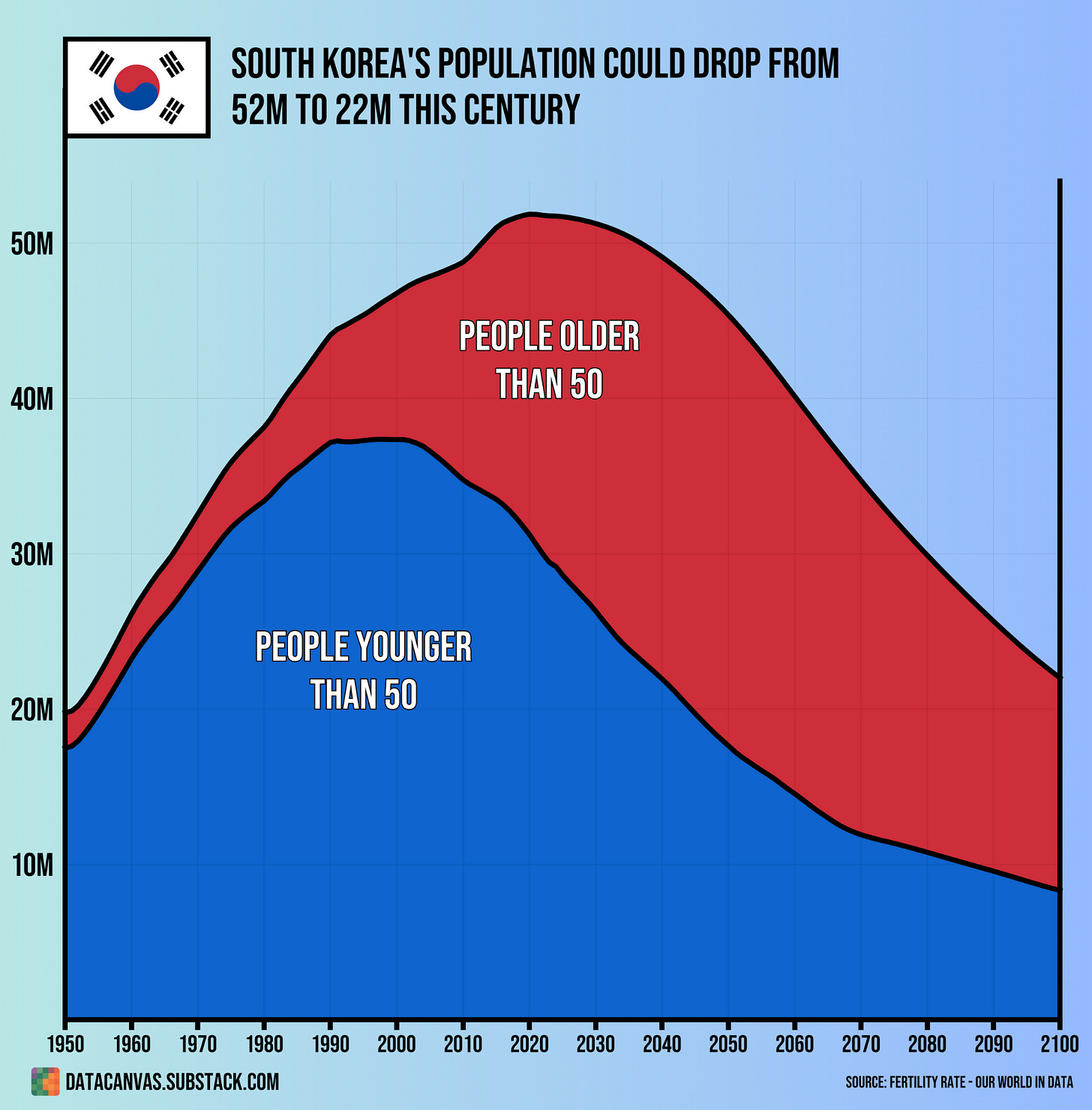South Korea's Fertility Crisis: A Glimpse into a Shrinking Future
Exploring South Korea's demographic challenges through data visualizations of historical data and UN projections.
Hi and welcome to a new episode of Data Canvas, where I create unique and beautiful data visualization describing critical global trends.
Today, we’re looking at the fertility rates and demography of South Korea.
As fertility rates continue to decline across the globe, many countries face a demographic shift. South Korea, is one of the most striking examples of this trend.
With the world’s lowest fertility rate in 2023, it’s population is expected to decrease by over 50% this century according to current estimates from the UN.
In this post, we will visualize and discuss data from the World Population Prospect to better understand the demography of South Korea and what their future might look like.
#1 The declining fertility rate of South Korea
Most countries have a declining fertility rate, which means that new generations are smaller than previous ones and, consequently, the population decreases over time.
In 2023, South Korea's fertility rate hit an all-time low of 0.72. This means that the generation born that year is roughly one-third the size of their parents' generation.
Imagine if this trend continues over multiple generations.
The following chart shows how South Korea’s fertility rate has dropped from a high of 6.18 in 1957 to 0.72 in 2023.
0.72 is actually the lowest recorded fertility rate for any country in the entire dataset. The only regions with a lower fertility rate than South Korea are Macao at 0.662 and Hong Kong at 0.717, neither of which are official countries.
There has been some positive news recently, with a continuous increase in childbirths for several straight months. In April 2025, both marriages and births had risen for 10 consecutive months. (source)
However, the fertility rate for April this year was still only 0.79, according to an article, which remains far from reassuring levels.
#2 The current demography of South Korea
The total population of South Korea is currently around 52 million people, and the country already has one of the world’s highest median ages. The fertility rate fell below replacement levels in the early 1980s, and the following population pyramid shows how generations have become smaller and smaller since then.
There is a clear cyclical trend in the pyramid, where a larger cohort of parents leads to more children in absolute terms.
You can also see a slight bulge just below the age of 30.
Since most women in South Korea have children later in life, we can expect there to be more children in absolute numbers in the next 5-10 years compared to what we see at the bottom of the population pyramid today.
#3 How will the demography change over time?
The next visualization is one I’m particularly proud of.
A few months ago, I realized that by removing gender from age distribution, we could create 2D illustrations that show how it changes over time. I first experimented with this approach in an article titled China's Age Distribution Over Time.
Today, I’ve improved upon my previous work by creating a similar chart for South Korea, incorporating feedback I received last time.
In the chart, you can see how much the age distribution has changed since 1950 and what the current projections suggest for 2100.
For example, there could be twice as many people older than 90 as children under the age of 10.
South Korea is an extreme case in terms of fertility rate, but many other countries are expected to experience similar trends. In fact, most developed countries have fertility rates well below replacement levels, and experts at the UN believe that a median age above 50 will become the norm.
#4 What could this mean for the population size?
People don’t live forever, which means that low fertility rates leads to a decrease in population when older generations disappear. For South Korea, that could potential mean a decrease of over 50% during this century.
Of course, most predictions turn out to be wrong.
Perhaps we will see birth rates recover as governments implement new subsidies, or maybe climate change will alter demographics in ways that current estimates cannot account for.
What ever happens, the World will look very different at the end of this century.
Thank you!
In conclusion, the decline in fertility rates is a global challenge that will shape the future of populations for generations to come. While South Korea is an extreme case, other countries face similar demographic challenges.
Thank you for reading! I hope this post has provided valuable insights into the demographic trends shaping our world. Please share your thoughts, questions, and feedback in the comments.








Thanks for sharing this critical piece, Oscar. I introduced the problem of shrinking futures in my primer https://amzn.to/3Iu42j8. My upcoming book will delve into some of the very challenges you've highlighted regarding South Korea's fertility crisis. I'll be exploring both the underlying societal dynamics and potential policy responses in greater depth. I'm looking forward to contributing to this crucial conversation.